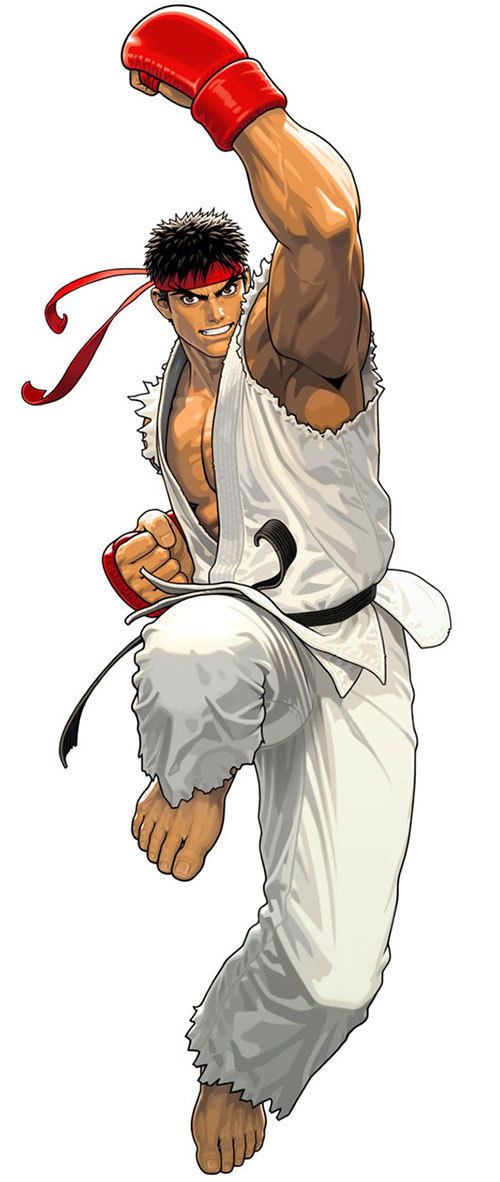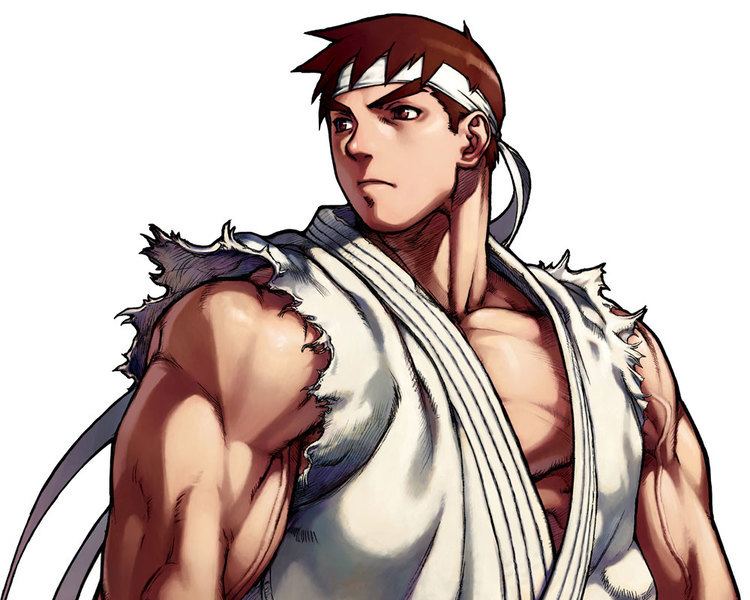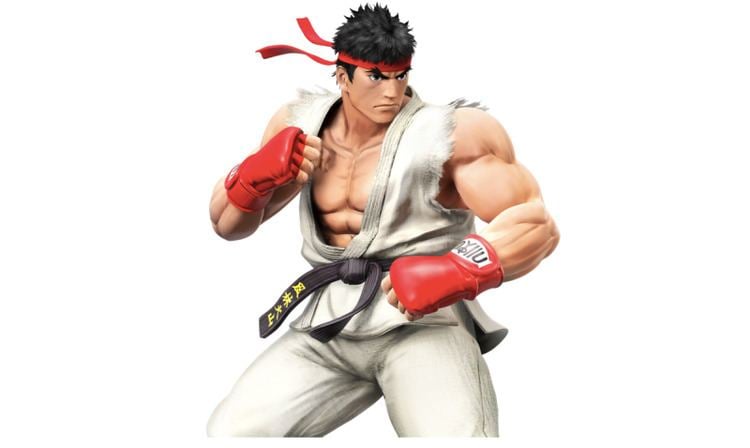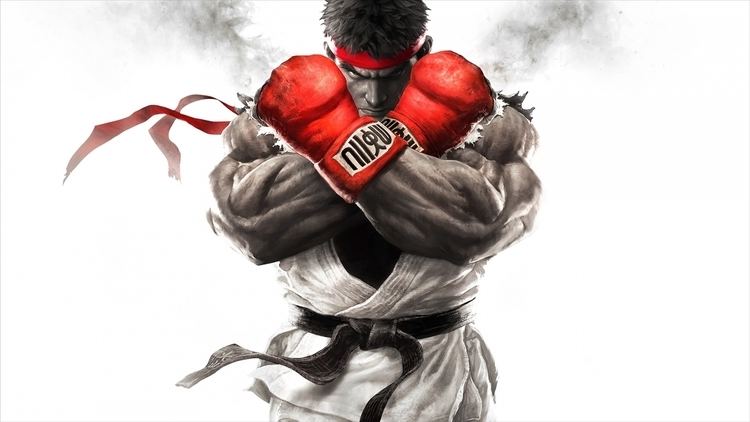Created by Manabu Takemura Publisher Capcom Fictional universe Street Fighter | First game Street Fighter (1987) Movies and TV shows Street Fighter | |
 | ||
Voiced by (English) Skip Stellrecht (SFII anime, SFII V Animaze, SFA: The Animation)Brett Weaver (SFII V, ADV #1)Tommy Drake (SFII V, ADV #2)Tong Lung (TV series)Richard Cansino (SFA: Generations)Kyle Hebert (SFIV, MvC3, SFxT, SSB 3DS/U, SFV, MvC:I, Wreck-It Ralph) Voiced by (Japanese) Katashi Ishizuka (SFA, SFA2, XvSF, MSHvSF, SFEX series)Toshiyuki Morikawa (SFA 3, MvC, MvC2, CvS series, Capcom Fighting Evolution, NxC)Hiroki Takahashi (TvC, SFIV, MvC3, Asura's Wrath, SFxT, PXZ, SSB 3DS/U, PXZ2, SFV, Granblue Fantasy)Wataru Takagi (SFIII: New Generation and SFIII: Second Impact)Tōru Ōkawa (SFIII: Third Strike)Sōichirō Hoshi (Super Puzzle Fighter II Turbo, Pocket Fighter)Kōji Tsujitani (SFII V)Kojiro Shimizu (SFII animated film)Kane Kosugi (SFA: The Animation)Yasuyuki Kase (SFA Generations)Bin Shimada (SFII drama CD)Masashi Ebara (first film Japanese dub)Shin-ichiro Miki (Real Battle on Film)Taketora (Wreck-It Ralph) Motion capture Byron Mann (The Movie games) Portrayed by Byron Mann (film)Jon Foo (short film)Mike Moh (Assassin's Fist) Birthplace JapanUnited States (1994 movie) Played by Mike Moh, Byron Mann, Kyle Hebert, Hiroki Takahashi, Kane Kosugi Similar Ken Masters, Chun‑Li, Akuma, M Bison, Guile | ||
History Of Ryu Street Fighter V
Ryu Hoshi, also known simply as Ryu, also written as Ryū in the original Street Fighter, is a fictional character and the protagonist from the Street Fighter series.
Contents
- History Of Ryu Street Fighter V
- In Street Fighter games
- Character design
- Gameplay
- In other games
- Live action
- Animation
- Comics
- Promotion and reception
- References

Having premiered in the first Street Fighter in 1987, Ryu appears as the lead character in the game, along with his best friend Ken Masters. Further games from the series show Ryu to be highly focused on his training, aiming to become the strongest he can. However, his powers also attract several criminals who want to use him for their plans, such as M. Bison. In some games, Ryu has an alternative form known as Evil Ryu (殺意の波動に目覚めたリュウ, Satsui no Hadō ni Mezameta Ryū, lit. "Ryu with the surge of murderous intent awakened", abbreviated Satsui Ryu in Street Fighter Alpha 3).

Ryu has been the lead character of the Street Fighter series since the first game and has appeared as a playable character in several crossover games involving the franchise, including the Marvel vs. Capcom series, Project X Zone, and Super Smash Bros. for Nintendo 3DS and Wii U. He is also featured in manga and anime adaptations as well as the 1994 live-action film.

In Street Fighter games

Ryu made his debut in the first Street Fighter as the primary playable character in the game, with his best friend, rival, and sparring partner Ken Masters serving as the second player's character. Both compete in the tournament depicted in the game in order to test their strength against the tournament's champion, Sagat.

His next appearance was in 1991's Street Fighter II. Set several years after Ryu defeated Sagat in the first tournament, Ryu participates in a second tournament. In his ending in the game, Ryu wins the tournament, but does not stay for the ceremony, already seeking his next challenge.
Ryu's backstory, along with those of other Street Fighter characters, would be explored in the subsequent Street Fighter Alpha prequel series. The first game, Street Fighter Alpha: Warriors' Dreams (1995), features Ryu confronting Sagat as his last opponent in a rematch following their first fight. Street Fighter Alpha 2 (1996) depicts Ryu on a quest to confront Akuma, his master's brother and enemy. After their match, Akuma reveals that Ryu possesses the "Evil Intent" (殺意の波動, Satsui no Hadō, lit. "Surge of Murderous Intent", sometimes translated as the "Dark Hadou") within him, the same power Akuma uses. In the Street Fighter Alpha series, there is an alternative selectable version of Ryu known as "Evil Ryu". Similarly to Akuma, Ryu takes this form when succumbing to the evil intent, and becomes more violent. It was not until the international versions of the game, Street Fighter Alpha 2, that Evil Ryu was introduced as a secret character in the games. Evil Ryu was originally introduced in a 1996 Street Fighter Zero manga series authored by Masahiko Nakahira and later adapted in the Street Fighter canon by Capcom. In Street Fighter Alpha 3 (1998), Ryu is sought by M. Bison, who seeks to use him as his next host body.
Ryu and Ken would return in Street Fighter III (1997) and its updates. While Ryu's motivation in the game and rivalry with Ken would remain the same, he was also shown getting acquainted with several of the new characters featured in the game. Ryu appears in Street Fighter IV, which takes place after Street Fighter II but before Street Fighter III. A new appearance of Evil Ryu in a Street Fighter game was confirmed in Super Street Fighter IV: Arcade Edition by a teaser trailer, and later confirmed as a secret boss and playable character by leaked video footage.
Ryu has appeared in spin-offs related to the main Street Fighter series such as the Street Fighter EX series produced by Arika. Byron Mann portrays the character in separately produced arcade and console games based on the American film of the series, both titled Street Fighter: The Movie, where he wears Ryu's characteristic white karate gi and red headband.
Character design
In the first Street Fighter game, Ryu wears a tattered white karate gi with the sleeves torn off, as well as a white hachimaki, red gloves, and red slippers. Also, a constant trait in his design is the Fūrinkazan (風林火山) kanji motif (meaning Wind, Forest, Fire, Mountain), battle standard of the historical Japanese military leader Takeda Shingen, embroidered into his obi, simulating Karate Dan degrees. In Street Fighter II Ryu is shown to be older, with brown hair, brown gloves, and a red hachimaki. He also fights barefooted starting in Street Fighter II. The Alpha series features a Ryu much like the one depicted in the original Street Fighter, with chestnut hair and a white hachimaki, but already barefoot. In the Street Fighter III games, Ryu has black hair and facial stubble. His glove design in Street Fighter IV features a simplified version of the Fūrinkazan characters. In Street Fighter V, Ryu's gi is not only tattered, but also has an off-white, soiled appearance to it.
Ryu's name was based on designer Takashi Nishiyama's name. This was due to the fact that the on'yomi (Sino-Japanese pronunciation) of the character "Takashi" is "Ryū" (Mandarin: Lóng 隆). Furthermore, Ryu's Hadouken energy attack was based on the wave motion gun from the titular spacecraft of the sci-fi anime series Space Battleship Yamato, which Nishiyama watched during the seventies. His other two techniques from the first Street Fighter game were inspired by actual martial arts moves which were exaggerated for the character. Because he was the only playable character in the original Street Fighter, Ryu's designer, Manabu Takemura, wanted to make him easy to identify with. In Street Fighter II, the character was selected for inclusion due to his presence in the first game, symbolizing the concept of a Japanese martial artist. As the series progressed, the design was made more muscular to coincide with the concept, while his white gi, considered his most defining characteristic by the development team, was meant to let viewers know he was "a karate master at first sight".
For Street Fighter IV, Kyle Hebert was cast as Ryu in preparation of the return of his "Evil Ryu" persona.
Gameplay
Ryu, in every game that he's appeared in, has always been classed as the "beginner's character" often being simple to learn and play and a way to teach players the system in the game. He can fit a range of playstyles, being able to play both offensively or defensively well.
Ryu's moveset featured in the Street Fighter series features three "special" attacks besides regular punches and kicks:
The velocity of the fireball depends on what punch button is pressed, with "light punch" or "jab" travels the slowest and "hard punch" or "fierce" traveling the fastest.
The distance that Ryu travels with the Hurricane Kick and the damage it does changes depending on the kick button pressed, with "light kick" or "short" traveling the least distance and dealing the least damage, but ends quicker. Pressing "hard kick" or "roundhouse" will travel the most distance and dealing the most damage, but leaves you open for punishment if blocked or jumped over.
In other games
Ryu has also been featured in Capcom's inter-company crossovers such as the Marvel vs. Capcom series, the SNK vs. Capcom series, Namco × Capcom, Tatsunoko vs. Capcom: Ultimate All-Stars, Project X Zone and Project X Zone 2. Some games of the SNK vs. Capcom series also include Evil Ryu as an unlockable character. In Marvel vs. Capcom: Clash of Super Heroes, Ryu has the ability to change his moveset to the ones from Ken or Akuma while fighting. He also appears in Super Puzzle Fighter II Turbo, a puzzle video game featuring super deformed characters along with the sequel, Super Gem Fighter Mini Mix, which is instead a fighting game, as well as in the mobile puzzle game Street Fighter: Puzzle Spirits. Ryu is one of the first fighters to appear as a playable fighter in the crossover fighting game Street Fighter X Tekken, and is also seen in the Tekken X Street Fighter poster along with Jin Kazama.
Onimusha: Dawn of Dreams features Ryu as an unlockable costume swap for the game's protagonist Soki. Although his incarnation there is much slimmer, this change is merely cosmetic and does not affect gameplay. Ryu also has a cameo appearance in the shooting game Varth: Operation Thunderstorm. He was also planned to appear in the now-cancelled game Mega Man Universe. A Ryu-inspired costume for players to use in Sony's LittleBigPlanet was released in 2008 as downloadable content for the title. A special downloadable episode in Asura's Wrath allows players to fight both Ryu and Evil Ryu. Ryu also appears as a playable character via downloadable content in the Nintendo crossover fighting games Super Smash Bros. for Nintendo 3DS and Wii U along with a stage based on his arena from Street Fighter II known as Suzaku Castle. He appears as a party member for a limited time event in the smartphone RPG, Granblue Fantasy, in a collaboration event titled "Ultra Granblue Fighter". Ryu will be a playable character in the upcoming Marvel vs. Capcom: Infinite.
Live-action
Ryu is played by Byron Mann in the 1994 film version of Street Fighter, where Guile is the lead character. The film depicts Ryu (given the surname "Hoshi") as Japanese American. He and Ken are a duo of traveling American con artists who steal money from rich crime lords through schemes such as selling modified toy guns. He and Ken eventually work with Guile to infiltrate M. Bison's headquarters. In the film's climax, Ryu personally fights and defeats Vega in battle. His rivalry with Sagat is notably absent in the film. Although Guile gives them their freedom, they choose to stay to help the clean up in Shadaloo and prefer to leave once the cleanup is done. In the film, Ryu's name is commonly incorrectly pronounced as "Raiyu", while Guile and Bison are the only characters in the film who pronounce his name correctly as "Reeyu".
Despite not appearing at all in Street Fighter: The Legend of Chun Li, Ryu is mentioned at the end of the movie as a formidable Japanese fighter entering a tournament.
Jon Foo also played Ryu (given the surname "Takashi") in the fan film Street Fighter: Legacy.
Daniel Southworth portrayed Ryu in the short film Street Fighter x Tekken: The Devil Within.
Ryu appears as a main lead alongside Ken in Street Fighter: Assassin's Fist portrayed by martial arts actor/stuntman Mike Moh. The film is set before the events of the games, and focuses on Ryu and Ken's training under Gouken, while flashbacks show Gouken's past with his brother Gouki/Akuma and their mentor, Goutetsu. Moh reprised his role as Ryu in the 5 part mini series Street Fighter: Resurrection and is slated to return in the second season titled Street Fighter: World Warrior.
Animation
In the 1994 film Street Fighter II: The Animated Movie, Ryu is the central character and focus of several other characters, namely Sagat, Guile and Bison himself. After Ryu defeats and scars Sagat in the film's opening, Bison commands a worldwide manhunt for him, determined to make him a brainwashed member of Shadaloo (here known as Shadowlaw), but is unable to find Ryu due to his travelling the world and ability to suppress his power, rendering Bison's monitor cyborgs unable to detect him. Throughout the film, Ryu comes into contact with several fighters, such as Fei-Long and E. Honda. Bison eventually captures and brainwashes Ken in Ryu's stead, which prompts Guile and Interpol to intercept Ryu before Bison can get to him, but Bison follows them and sets Ken on Ryu, who refuses to fight his controlled friend back. Eventually, Ken manages to break free of Bison's control and the two ultimately work together to defeat Bison. The final scene, however, makes it clear that Bison survived, and he ambushes Ryu, who prepares to fight him again. He was voiced by Kōjirō Shimizu in the Japanese version and Skip Stellrecht in the English dub.
Ryu also appears in the American TV series and is once again replaced by Guile as the protagonist since it is a continuation of the 1994 live-action film. Near the end of the series, however, the story shifts focus to Ryu and Ken, making them more prominent as they face several enemies such as the Mad Gear gang. In both the film and the series, Ryu's name is incorrectly pronounced as "Raiyu", though in the movie Guile and Bison are the only ones to pronounce his name correctly.
The premise of the 1995 Japanese TV series Street Fighter II V centers around a young Ryu and Ken, who travel the world with Chun-Li to improve their martial art skills by challenging other fighters. He was voiced Kōji Tsujitani in the Japanese version and once again by Skip Stellrecht in the English Animaze dub, while in the ADV Films dub he was portrayed by Brett Weaver and then later by Tommy Drake.
The 1999 original video animation Street Fighter Alpha: The Animation centers around Ryu's inner conflict with the Dark Hadou, as seen in the Street Fighter Alpha manga and games, though adding original elements such as the appearance of Ryu's supposed younger brother, Shun, and their conflict with Professor Sadler and Rosanov. The 2005 OVA Street Fighter Alpha: Generations features a similar storyline, but is unrelated to the previous Alpha anime. The latter implies Ryu to be the biological son of Akuma.
Ryu made cameo appearances in the Disney film Wreck-It Ralph, with Kyle Hebert reprising his role. He first appears in a sparring match with Ken and decides to go to Tapper for a drink after the fight.
Comics
Udon Entertainment's comic book adaptation of the Street Fighter plot places Ryu in the center of the events of the plot. Ryu grows up training in the art of Ansatsuken and all the while fighting off the urge of the Satsui no Hadō. He trains to be a strong fighter without relying on the hatred and consumption it brings. After returning from the first Street Fighter tournament, Ryu discovers and thinks that his master (Gouken) has been slain by his brother (Akuma) and sets out (along with Ken) to avenge his death by fighting him. Like in the Alpha series, Ryu is a young powerful fighter who shows great potential, this draws the attention of Bison as well as Chun-Li and Guile, who believe there is a criminal connection between the two at first. He also trains Sakura during the second arc of the comics and later on trains with other fighters (specifically Dhalsim and Gen) to give himself a better chance against Akuma. Like in the official story, Sagat is consumed with thoughts of revenge against Ryu for losing his honor and even his pride at the first Street Fighter tournament but he does seek him out to warn him of Shadaloo's advances in order to fight him in a fair match. During the final series of comics, Ryu attends Bison's tournament and advances all the way to the final stage (including getting his long-awaited rematch with Sagat and won). However, before he is able to fight Bison, Akuma intervenes and soundly defeats Bison instead with ease. The plot then shifts to the battle between Akuma and Ryu as the concluding fight of the comic series. During the battle, Ryu is almost corrupted by the Satsui no Hadou to defeat Akuma at any cost but refuses the power, which allows Akuma the upper hand in battle. All seems lost but at the very last moment, Gouken returns and he finishes the battle with Akuma. Ryu passes out before the fight can conclude and is rescued from the sinking island by Dhalsim. Following the battle, Ryu believes he no longer needs to rely on it if he wants victory.
Promotion and reception
Ryu is consistently ranked as one of the most popular and memorable characters from the Street Fighter franchise as well as gaming in general among critics. GameSpot featured him in their article "All Time Greatest Game Hero". He additionally ranked number seventy-one on UGO Networks's "Top 100 Heroes of All Time" article. UGO also placed him at #2 on their list of "Top 50 Street Fighter Characters", stating "Whereas Ken is flashy, Ryu is contemplative, tortured and driven." IGN ranked him first in their "Top 25 Street Fighter Characters" article, stating "Ryu is a testament to the virtue of simplicity in character design. White gi, dark gloves, red headband for a little touch of color, and that is it. It's rare, when you think about it, to see too many fancy pieces go into the making of an icon". GameDaily listed him at number two in their "Top 20 Street Fighter Characters of All Time" article, stating "He always seeks a bigger challenge, and that determination makes him one of our favorites"; in a later character profile article for Ryu, they stated "Ryu is a formidable fighter that gets the job done.... Bottom line, you can't go wrong with Street Fighter's most iconic character." The same site ranked him sixth along with Ken in the Top 25 Capcom Characters of All Time with editor Robert Workman saying "It was just impossible to choose between one of these world warriors". He has also been recognized as one of the best gaming characters from all time. He was voted as one of the best fifty characters in both a Famitsu issue and the Guinness World Records Gamer's Edition from 2011. In the February 1992 issue of Gamest magazine in Japan Ryu ranked third Best Character of 1991. In the January 30, 1997 issue Ryu ranked number thirteen in Top 50 Characters of 1996. In a 2010 survey of 4000 online matches for Super Street Fighter IV, Ryu was the most popular character, with 16.6% of the usage. In 2011, Empire ranked him as the 27th greatest video game character, adding "he has remained the definitive beat-'em-up fighter and go-to-guy for the discerning player since the days of SF2."
GamesRadar writer Tyler Wilde published an article focusing on Ken's and Ryu's development across the franchise under the title of "The evolution of Ken and Ryu". The Guardian recommended Ryu and Ken for beginners in Street Fighter IV with the former being better at fights from distances as a result of his projectiles moves. In GameSpot's "Great Loves" article Ryu was described as "one of the most independent men in the world of video games" as he is only interested in training to become stronger fighter in contrast to other Street Fighter characters who have romantic interests. UGO listed Ryu's headband twenty-sixth on their list of "The Coolest Helmets and Headgear in Video Games". In GamesRadar's article "The 56 characters of Marvel vs Capcom 2", Ryu was described as "The heart and soul of the Street Fighter series" and "probably the most well known fighting game character in the world".
Evil Ryu was noted to be a trope of protagonist gaming characters who reveal an evil alter-ego. UGO Networks editor Paul Furfari chose him as one of the top 50 best Street Fighter characters, commenting that despite being a "what if" form from Ryu, it made the Street Fighter Alpha series more entertaining due to the potential his moves had. Such form shown in Super Street Fighter IV: Arcade Edition was noted to share traits from both Ryu and Akuma. GameSpot stated that since he uses modified versions from known techniques, he was one of the least interesting additions to the game. His stronger damage executed have been commented to the point Game Informer mentioned he was even stronger than Seth, the Street Fighter IV boss. In a GamesRadar article by Michael Grimm, a fight between Evil Ryu and Devil Jin was written as one of the ones players wanted to see in Street Fighter X Tekken as the two are evil alter egos from two existing characters sharing also similar designs and movesets to their original forms. In 2016, Screen Rant named Ryu along with his Evil Ryu form the "5th Most Powerful Street Fighter Character", with comments "Naturally, the poster boy of the series ranks high on a list like this. As his hypothetical Evil Ryu incarnation shows, he definitely has the capacity to unleash some scary power upon the world."
One of Ryu's quotes from Street Fighter II stated "You must defeat Sheng Long to stand a chance." Such a quote caused controversy among gamers, who wondered whether there was actually a character named Sheng Long. Although the quote was actually a mistranslation, it was exploited as an April Fools' joke various times by gaming magazines. Nevertheless, the character was referred in the video games based on live-action films as Ryu's teacher. Moreover, the fans' request to include Sheng Long, led to Gouken's inclusion in Street Fighter IV.
